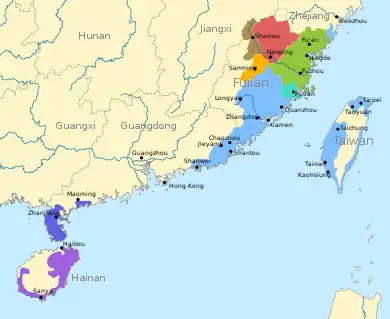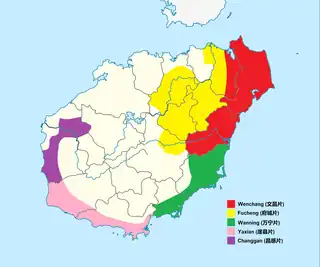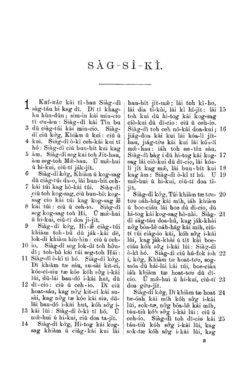Hainanese
Hainanese (Hainan Romanised: Hái-nâm-oe, Hainanese Pinyin: Hhai3 nam2 ue1,simplified Chinese: 海南话; traditional Chinese: 海南話; pinyin: Hǎinánhuà), also known as Qiongwen (simplified Chinese: 琼文; traditional Chinese: 瓊文) or Qiongyu (琼语; 瓊語),[6] is a group of Min Chinese varieties spoken in the southern Chinese island province of Hainan and Overseas Chinese such as Malaysia. In the classification of Yuan Jiahua, it was included in the Southern Min group, being mutually unintelligible with other Southern Min varieties such as Hokkien–Taiwanese and Teochew.[7] In the classification of Li Rong, used by the Language Atlas of China, it was treated as a separate Min subgroup.[8] Hou Jingyi combined it with Leizhou Min, spoken on the neighboring mainland Leizhou Peninsula, in a Qiong–Lei group.[9] "Hainanese" is also used for the language of the Li people living in Hainan, but generally refers to Min varieties spoken in Hainan.
| Hainanese | |
|---|---|
| Qiongwen | |
| 海南話, Hhai3 nam2 ue1, Hái-nâm-oe | |
| Pronunciation | [hai˨˩˧ nam˨˩ ue˨˧] (Haikou dialect) |
| Native to | China, Singapore, Thailand |
| Region | Hainan |
| Ethnicity | Hainanese |
Native speakers | Around 5 million in China (2002)[1] |
| Dialects | |
| Chinese characters Hainan Romanized | |
| Language codes | |
| ISO 639-3 | (hnm is proposed[5]) |
| Glottolog | hain1238 |
| Linguasphere | 79-AAA-k |
 Hainanese | |
 Varieties of the Hainanese spoken in Hainan. | |

Phonology
The phonologies of the different varieties of Hainanese are highly divergent,[10] with the Wenchang dialect being the prestige dialect, and often used as a reference.[11]
Consonants
Below is a table for the consonants of Hainanese across the dialects of Wenchang, Haikou and Banqiao.[10] For more information on a specific variety, please consult the relevant article.
| Labial | Dental | Alveolo- palatal | Velar | Glottal | |||
|---|---|---|---|---|---|---|---|
| Plosive | voiceless | /p/[lower-roman 1] 爸 pa | /t/ 洗 toi | /k/ 公 kong | /ʔ/ 啊 a | ||
| aspirated | /pʰ/[lower-roman 1][lower-roman 2] 婆 pho | /tʰ/[lower-roman 1] | /kʰ/[lower-roman 1][lower-roman 2] 去 khu | ||||
| voiced | /b/[lower-roman 3] | /d/[lower-roman 3] | /g/[lower-roman 4] 我 gua | ||||
| implosive | /ɓ/[lower-roman 3][lower-roman 2] 北 ɓak | /ɗ/[lower-roman 3][lower-roman 2] 茶 ɗei | (/ɠ/)[lower-roman 5] | ||||
| Affricate | voiceless | /ts/[lower-roman 1][lower-roman 2] | /tɕ/[lower-roman 4] 食 tsia | ||||
| aspirated | /tsʰ/[lower-roman 1] | ||||||
| voiced | /dz/[lower-roman 1] | /dʑ/[lower-roman 4] 日 jit | |||||
| Fricative | voiceless | /ɸ/[lower-roman 4] 皮 fi | /θ/[lower-roman 1] | /s/ 事 sei | /ɕ/[lower-roman 4][lower-roman 2] | /x/ | /h/ 海 hai |
| voiced | /v/[lower-roman 1][lower-roman 2] 文 vun | /z/[lower-roman 2] 欲 zok | /ɦ/[lower-roman 4] | ||||
| Nasal | /m/ 目 mak | /n/ 念 niam | /ŋ/ 乐 ngak | ||||
| Approximant | /w/[lower-roman 4] 发 wat | /l/ 老 lao | /j/[lower-roman 4] 肉 yok | ||||
- Present in the Banqiao dialect.
- Present in the Haikou dialect.
- Present in the Wenchang dialect, where there is a phonemic distinction between voiced and implosive stop consonants.
- Present in the Wenchang dialect.
- Not usually transcribed as /ɠ/, and not phonemically distinct from /g/ in the Wenchang dialect or from /ŋ/ in other Hainanese varieties.[12]
Many of the mostly widely spoken varieties Hainanese notably have a series of implosive consonants, /ɓ/ and /ɗ/, which were acquired through contact with surrounding languages, probably Hlai. However, more conservative varieties of Hainanese such as Banqiao remain closer to Teochew and other varieties of Southern Min, lack them.[10]
The consonant system of Hainanese corresponds well with that of Hokkien, but it has had some restructuring. In particular:[10]
- Etymological plain stops have undergone implosivization (*p > [ɓ], *t > [ɗ]) in the more innovative varieties such as Wenchang and Haikou.
- Etymological aspirated stops have spirantized (*pʰ > [ɸ], *tʰ > [h], *tsʰ > [ɕ], *kʰ > [h~x]) in more innovative varieties.
- The lenition of an historic *b into [v] in Banqiao and Haikou, though not in Wenchang.
- Former *s has hardened into a stop (*s > [t]), although in the more conservative Banqiao dialect some instances have only undergone fortition to (*s > [θ]), and others have remained [s].
- Former *h has become [ɦ] in Wenchang.
Additionally, [ʑ] is an allophone of /j/.
These changes also make Hainanese fairly close to Sino-Vietnamese vocabulary.
| Chinese character | Mandarin | Taiwanese Hokkien | Haikou Hainanese | Sino-Vietnamese |
|---|---|---|---|---|
| 邪 | xié | siâ | dia2 | da |
| 仙 | xiān | sian | din1 | tiên |
| 散 | sàn | suànn | dan4 | tàn |
| 跡 | jì | jiak | di1 | tích |
| 神 | shén | sîn | din2 | thần |
| 痴 | chī | chi | si1 | si |
Vowels
Hainanese has seven phonemic vowels .
| Front | Central | Back | |
|---|---|---|---|
| Close | /i/ | /u/ | |
| Close-mid | /e/ | /o/ | |
| Open-mid | /ɛ/ | /ɔ/ | |
| Open | /a/ |
Tones
| Tone number | Tone name | Tone contour | Example |
|---|---|---|---|
| 1 | yin ping (阴平) | ˨˦ (24) | 诗 |
| 2 | yang ping (阳平) | ˨˩ (21) | 时 |
| 3 | yin shang (阴上) | ˨˩˩ (211) | 死 |
| 4 | yin qu (阴去) | ˧˥ (35) | 四 |
| 5 | yang qu (阳去) | ˧ (33) | 是 |
| 6 | yin ru (阴入) | ˥ (5) | 失 |
| 7 | yang ru (阳入) | ˧ (3) | 实 |
| 8 | chang ru (长入) | ˥ (55) | 视 |
Romanization
Hainanese Pinyin
Hainanese Pinyin (海南话拼音方案) is a phonetic system announced by the Education Administration Department of Guangdong Province in September 1960. It marks tones with numbers.
Initials
| IPA | Hainanese Pinyin | Bǽh-oe-tu | Example |
|---|---|---|---|
| /ɓ/ | b | b | 北 |
| /p/ | b | p | 波 |
| /pʰ/ | p | ph | 坡 |
| /ɸ/ | p | f | 皮 |
| /m/ | m | m | 摩 |
| /b/ | v | b | ? |
| /v/ | v | v | 无 |
| /t/ | d | t | 装 |
| /ɗ/ | dd | d | 刀 |
| /n/ | n | n | 挪 |
| /l/ | l | l | 罗 |
| /k/ | g | k | 哥 |
| /ŋ/ | ng | g | 俄 |
| /x/ | h | kh | 可 |
| /h/ | hh | h | 号 |
| /ɠ/ | gh | g | 我 |
| /ts/ | z | c | 支 |
| /s/ | s | s | 妻 |
| /z/ | y | j | 余 |
Finals
| IPA | Hainanese Pinyin | Bǽh-oe-tu | Example |
|---|---|---|---|
| /a/ | a | a | 亚 |
| /o/ | o | o | 荷 |
| /ɛ/ | e | e | 摩 |
| /i/ | i | i | 医 |
| /u/ | u | u | 呜 |
| ai | ai | ai | 哀 |
| ɔi | oi | oi | 鞋 |
| au | ao | au | 喉 |
| ia | ia | ia | 也 |
| iɔ | io | io | 腰 |
| ua | ua | oa | 换 |
| ue | ue | oe | 话 |
| ui | ui | oi | 威 |
| uai | uai | oai | 坏 |
| ɔu | ou | ou | 黑 |
| iu | iu | iu | 柚 |
| iau | iao | iau | 妖 |
| iam | iam | iam | 厌 |
| im | im | im | 音 |
| am | am | am | 暗 |
| an | an | an | 安 |
| in | in | in | 烟 |
| un | un | un | 温 |
| uan | uan | oan | 弯 |
| aŋ | ang | ag | 红 |
| eŋ | eng | eg | 英 |
| ɔŋ | ong | og | 翁 |
| iaŋ | iang | iag | 央 |
| uaŋ | uang | oag | 汪 |
| iɔŋ | iong | iog | 匈 |
| ip | ib | ib | 邑 |
| iap | iab | iab | 协 |
| at | ad | at | 遏 |
| it | id | it | 乙 |
| ut | ud | ut | 核 |
| uat | uad | oat | 挖 |
| ak | ag | ak | 鹤 |
| ek | eg | ek | 益 |
| ok | og | ok | 喔 |
| iok | iog | iok | 育 |
| uak | uag | oak | 廓 |
| -ʔ | -h | -h | 不 |
See also
- Hainanese culture
- Hainanese people
Notes
References
- Hou, Jingyi 侯精一 (2002). Xiàndài Hànyǔ fāngyán gàilùn 现代汉语方言概论 [An Introduction to Modern Chinese Dialects]. Shanghai Educational Press 上海教育出版社. pp. 207–208.
- Mei, Tsu-lin (1970), "Tones and prosody in Middle Chinese and the origin of the rising tone", Harvard Journal of Asiatic Studies, 30: 86–110, doi:10.2307/2718766, JSTOR 2718766
- Pulleyblank, Edwin G. (1984), Middle Chinese: A study in Historical Phonology, Vancouver: University of British Columbia Press, p. 3, ISBN 978-0-7748-0192-8
- Hammarström, Harald; Forkel, Robert; Haspelmath, Martin; Bank, Sebastian (2023-07-10). "Glottolog 4.8 - Min". Glottolog. Leipzig: Max Planck Institute for Evolutionary Anthropology. doi:10.5281/zenodo.7398962. Archived from the original on 2023-10-13. Retrieved 2023-10-13.
- "Change Request Documentation: 2021-045". 31 August 2021. Retrieved 30 May 2022.
- "为新加坡琼属"寻根"的热心人——王振春". Hainan.gov (in Chinese). 中新海南网. Archived from the original on 22 March 2020. Retrieved 22 March 2020.
他组织演出琼语话剧《海南四条街》,搬上新琼舞台,引起两地海南人的共鸣。
- Simons, Gary F.; Fennig, Charles D., eds. (2017). Ethnologue: Languages of the World (20th ed.). Dallas, Texas: SIL International. Chinese, Min Nan.
- Kurpaska, Maria (2010). Chinese Language(s): A Look Through the Prism of "The Great Dictionary of Modern Chinese Dialects". Walter de Gruyter. pp. 54–55, 86. ISBN 978-3-11-021914-2.
- Hou, Jingyi 侯精一 (2002). Xiàndài Hànyǔ fāngyán gàilùn 现代汉语方言概论 [An Introduction to Modern Chinese Dialects]. Shanghai Educational Press 上海教育出版社. p. 238.
- Huang, Karen (2006). "Contact-induced changes in the languages of Hainan". Annual Student Conference of the College of Languages, Linguistics, and Literature. University of Hawaii.
- "其中文昌话语音清晰,影响较大,被视为海南话的标准语,是海南广播电台、电视台与社会使用的主要方言。" From "《文昌县志·第二十九编 社会习俗·第三章 方言》". Archived from the original on 2015-05-18. Retrieved 2023-10-23.
- "Amaravati: Abode of Amritas: 08.6.20.23:50: HAINANESE 缩气音 'SHRUNKEN BREATH SOUNDS'". www.amritas.com.
*Xu and Yang regard [g] (their gz) as an implosive, but it sounds like a regular [g] to me. I presume Li Fang-kuei also heard a regular [g], as he only reported two implosives in Haina[n]ese: [ɓ ɗ].
Further reading
- Chang, Kuang-yu (1986). Comparative Min phonology (PhD thesis). University of California, Berkeley.
- Chen, Hongmai (1996). Hǎikǒu fāngyán cídiǎn 海口方言詞典 [Haikou dialect dictionary]. Great Dictionary of Modern Chinese Dialects. Vol. 16. Nanjing: Jiangsu Education Press. ISBN 978-7-5343-2886-2.
- Huang, Karen. "Contact-induced changes in the languages of Hainan". Annual Student Conference of the College of Languages, Linguistics, and Literature. University of Hawaii.
- Kwok, Bit-chee (2006). "The role of language strata in language evolution: three Hainan Min dialects". Journal of Chinese Linguistics. 34 (2): 201–291. JSTOR 23754124.
- Miyake, Marc. 2008. Hainanese articles.
- Miyake, Marc. 2008. Hainanese -om and -op.
- Norman, Jerry Lee (1969). The Kienyang Dialect of Fukien (PhD thesis). University of California, Berkeley. includes a description of the phonology of the Ding'an dialect.
- Solnit, David B. (1982). "Linguistic Contact in Ancient South China: The Case of Hainan Chinese, Be, and Vietnamese". Proceedings of the Eighth Annual Meeting of the Berkeley Linguistics Society. 8: 219–230. doi:10.3765/bls.v8i0.2041.
- Woon, Wee-Lee (1979a). "A synchronic phonology of Hainan dialect: Part I". Journal of Chinese Linguistics. 7 (1): 65–100. JSTOR 23753034. describes Wenchang dialect.
- Woon, Wee-Lee (1979b). "A synchronic phonology of Hainan dialect: Part II". Journal of Chinese Linguistics. 7 (2): 268–302. JSTOR 23752923.
- Yan, Margaret Mian (2006). Introduction to Chinese Dialectology. LINCOM Europa. ISBN 978-3-89586-629-6.
External links
- Learn hainanese Archived 2018-07-01 at the Wayback Machine

